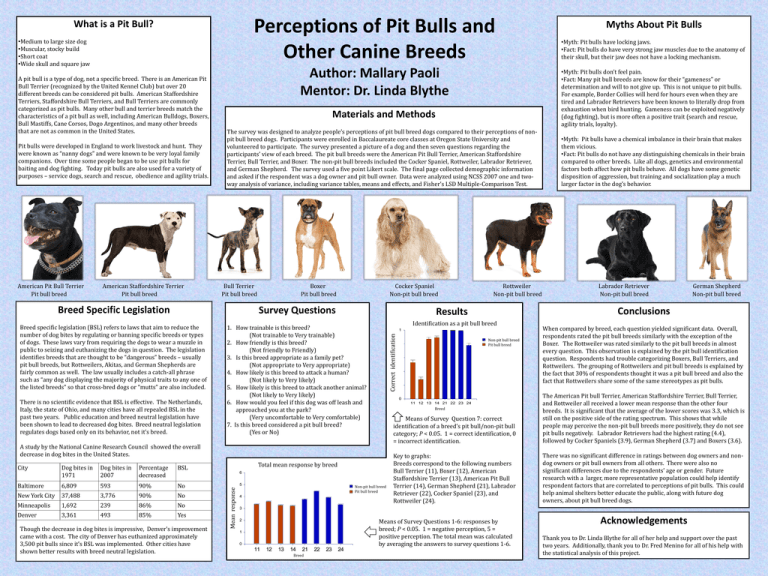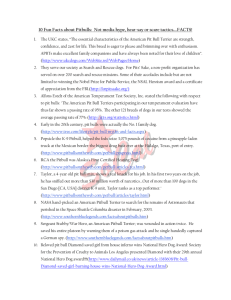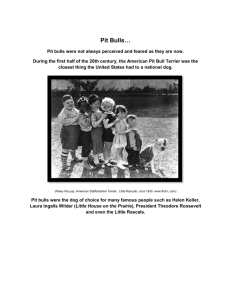Perceptions of Pit Bulls and Other Canine Breeds Myths About Pit Bulls
advertisement

Perceptions of Pit Bulls and Other Canine Breeds What is a Pit Bull? •Medium to large size dog •Muscular, stocky build •Short coat •Wide skull and square jaw A pit bull is a type of dog, not a specific breed. There is an American Pit Bull Terrier (recognized by the United Kennel Club) but over 20 different breeds can be considered pit bulls. American Staffordshire Terriers, Staffordshire Bull Terriers, and Bull Terriers are commonly categorized as pit bulls. Many other bull and terrier breeds match the characteristics of a pit bull as well, including American Bulldogs, Boxers, Bull Mastiffs, Cane Corsos, Dogo Argentinos, and many other breeds that are not as common in the United States. Pit bulls were developed in England to work livestock and hunt. They were known as “nanny dogs” and were known to be very loyal family companions. Over time some people began to be use pit bulls for baiting and dog fighting. Today pit bulls are also used for a variety of purposes – service dogs, search and rescue, obedience and agility trials. American Staffordshire Terrier Pit bull breed The survey was designed to analyze people’s perceptions of pit bull breed dogs compared to their perceptions of nonpit bull breed dogs. Participants were enrolled in Baccalaureate core classes at Oregon State University and volunteered to participate. The survey presented a picture of a dog and then seven questions regarding the participants’ view of each breed. The pit bull breeds were the American Pit Bull Terrier, American Staffordshire Terrier, Bull Terrier, and Boxer. The non-pit bull breeds included the Cocker Spaniel, Rottweiler, Labrador Retriever, and German Shepherd. The survey used a five point Likert scale. The final page collected demographic information and asked if the respondent was a dog owner and pit bull owner. Data were analyzed using NCSS 2007 one and twoway analysis of variance, including variance tables, means and effects, and Fisher’s LSD Multiple-Comparison Test. Bull Terrier Pit bull breed Breed Specific Legislation Boxer Pit bull breed Cocker Spaniel Non-pit bull breed Survey Questions Breed specific legislation (BSL) refers to laws that aim to reduce the number of dog bites by regulating or banning specific breeds or types of dogs. These laws vary from requiring the dogs to wear a muzzle in public to seizing and euthanizing the dogs in question. The legislation identifies breeds that are thought to be “dangerous” breeds – usually pit bull breeds, but Rottweilers, Akitas, and German Shepherds are fairly common as well. The law usually includes a catch-all phrase such as “any dog displaying the majority of physical traits to any one of the listed breeds” so that cross-bred dogs or “mutts” are also included. There is no scientific evidence that BSL is effective. The Netherlands, Italy, the state of Ohio, and many cities have all repealed BSL in the past two years. Public education and breed neutral legislation have been shown to lead to decreased dog bites. Breed neutral legislation regulates dogs based only on its behavior, not it’s breed. 1. How trainable is this breed? (Not trainable to Very trainable) 2. How friendly is this breed? (Not friendly to Friendly) 3. Is this breed appropriate as a family pet? (Not appropriate to Very appropriate) 4. How likely is this breed to attack a human? (Not likely to Very likely) 5. How likely is this breed to attack another animal? (Not likely to Very likely) 6. How would you feel if this dog was off leash and approached you at the park? (Very uncomfortable to Very comfortable) 7. Is this breed considered a pit bull breed? (Yes or No) Percentage decreased BSL Baltimore 6,809 593 90% No New York City 37,488 3,776 90% No Minneapolis 1,692 239 86% No Denver 3,361 493 85% Yes Though the decrease in dog bites is impressive, Denver’s improvement came with a cost. The city of Denver has euthanized approximately 3,500 pit bulls since it’s BSL was implemented. Other cities have shown better results with breed neutral legislation. Total meanresponse response Total mean by breed Identification as a by pitbreed bull breed 6 1 5 4 3 2 1 Correct identification Dog bites in 2007 •Myth: Pit bulls have a chemical imbalance in their brain that makes them vicious. •Fact: Pit bulls do not have any distinguishing chemicals in their brain compared to other breeds. Like all dogs, genetics and environmental factors both affect how pit bulls behave. All dogs have some genetic disposition of aggression, but training and socialization play a much larger factor in the dog’s behavior. Labrador Retriever Non-pit bull breed German Shepherd Non-pit bull breed Conclusions Identification as a pit bull breed response Mean response mean Total Dog bites in 1971 Rottweiler Non-pit bull breed Results A study by the National Canine Research Council showed the overall decrease in dog bites in the United States. City •Myth: Pit bulls have locking jaws. •Fact: Pit bulls do have very strong jaw muscles due to the anatomy of their skull, but their jaw does not have a locking mechanism. •Myth: Pit bulls don’t feel pain. •Fact: Many pit bull breeds are know for their “gameness” or determination and will to not give up. This is not unique to pit bulls. For example, Border Collies will herd for hours even when they are tired and Labrador Retrievers have been known to literally drop from exhaustion when bird hunting. Gameness can be exploited negatively (dog fighting), but is more often a positive trait (search and rescue, agility trials, loyalty). Materials and Methods 1 Not pit breed Non-pit bullbull breed Pit breed Pit bullbull breed 12 0 13 14 21 22 23 24 Breed Breed 11 12 13 14 21 22 23 24 Breed When compared by breed, each question yielded significant data. Overall, respondents rated the pit bull breeds similarly with the exception of the Boxer. The Rottweiler was rated similarly to the pit bull breeds in almost every question. This observation is explained by the pit bull identification question. Respondents had trouble categorizing Boxers, Bull Terriers, and Rottweilers. The grouping of Rottweilers and pit bull breeds is explained by the fact that 30% of respondents thought it was a pit bull breed and also the fact that Rottweilers share some of the same stereotypes as pit bulls. Means of Survey Question 7: correct identification of a breed’s pit bull/non-pit bull category; P < 0.05. 1 = correct identification, 0 = incorrect identification. The American Pit bull Terrier, American Staffordshire Terrier, Bull Terrier, and Rottweiler all received a lower mean response than the other four breeds. It is significant that the average of the lower scores was 3.3, which is still on the positive side of the rating spectrum. This shows that while people may perceive the non-pit bull breeds more positively, they do not see pit bulls negatively. Labrador Retrievers had the highest rating (4.4), followed by Cocker Spaniels (3.9), German Shepherd (3.7) and Boxers (3.6). Key to graphs: Breeds correspond to the following numbers Bull Terrier (11), Boxer (12), American Staffordshire Terrier (13), American Pit Bull Terrier (14), German Shepherd (21), Labrador Not pit breed Non-pit bullbull breed PitPit bullbull breed breed Retriever (22), Cocker Spaniel (23), and Rottweiler (24). There was no significant difference in ratings between dog owners and nondog owners or pit bull owners from all others. There were also no significant differences due to the respondents’ age or gender. Future research with a larger, more representative population could help identify respondent factors that are correlated to perceptions of pit bulls. This could help animal shelters better educate the public, along with future dog owners, about pit bull breed dogs. 0 11 12 13 14 21 22 23 24 Breed Breed Means of Survey Questions 1-6: responses by breed; P < 0.05. 1 = negative perception, 5 = positive perception. The total mean was calculated by averaging the answers to survey questions 1-6. 0 11 Identification as a pit bull breed Correct identification Correct identification American Pit Bull Terrier Pit bull breed Author: Mallary Paoli Mentor: Dr. Linda Blythe Myths About Pit Bulls Acknowledgements Thank you to Dr. Linda Blythe for all of her help and support over the past two years. Additionally, thank you to Dr. Fred Menino for all of his help with the statistical analysis of this project.





